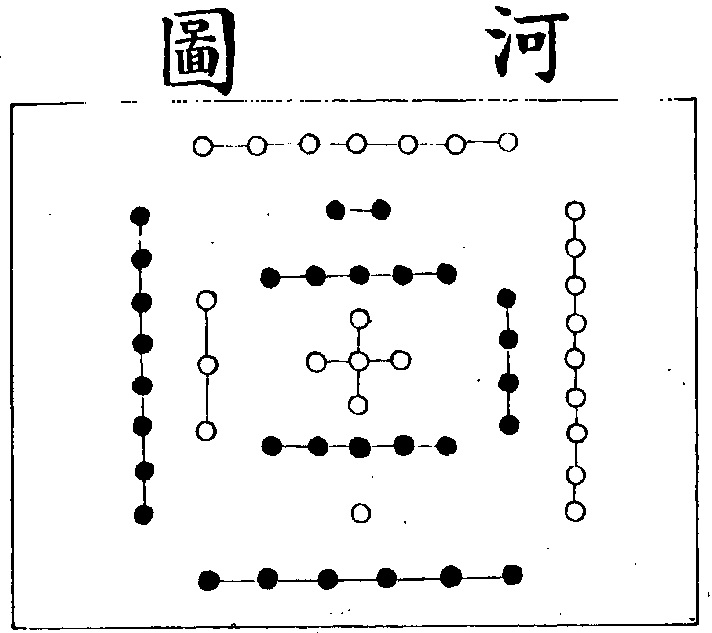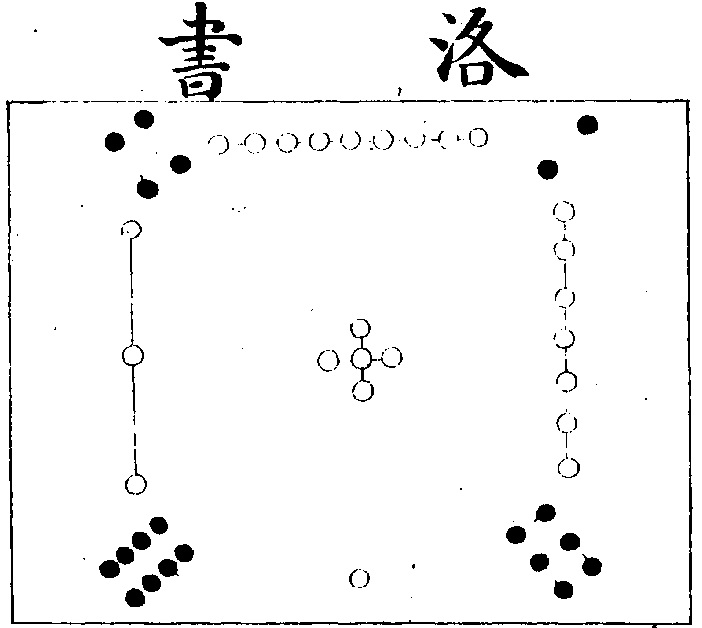The Hetu 河圖 "Yellow River Chart" and the Luoshu 洛書 (also written 雒書) "Inscription of the River Luo" were two cosmological diagrams used in ancient China. They were employed by both Daoists and Confucians and served to explain the correlation of the hexagrams of the Yijing 易經 "Book of Changes" with the universe and human life. They are also used in geomancy (fengshui 風水).
The two diagrams are first mentioned in the chapter Guming 顧命 of the Confucian Classic Shangshu 尚書 "Book of Documents", where it is said that the three precious jades and the hetu were stored in the Eastern Chamber. It can thus be assumed that the Hetu was a kind of jade stone, the texture of which was interpreted as the eight trigrams (bagua 八卦) of the Yijing.
 |
 |
Source: Zhu Xi 朱熹, Zhouyi benyi 周易本義, Siku quanshu edition. |
The Han period 漢 (206 BCE-220 CE) scholar Kong Anguo 孔安國, author of a commentary on the Shangshu, was the first who who mentioned the legend of a dragon horse (longma 龍馬) that emerged out of the Yellow River. Its back was said to be patterned with the shape of the eight trigrams. The diagram on the back of the horse was the so-called "River Chart" that was fixed by the mythological emperor Fu Xi 伏羲 and was preserved in the shape of the eight trigrams.
As an auspicious omen, the horse is reported to have regularly appeared during the reigns of the virtuous rulers Yao 堯, Shun 舜, and Yu 大禹. Confucius 孔子 lamented that during his lifetime, the miraculous horse (often translated as "unicorn") did not appear again, which was a bad portent of unlucky times.
The "Inscription of the River Luo" is first mentioned in the book Guanzi 管子, where it is said that a dragon turtle (longgui 龍龜) left the waters of the River Luo, so that an inscription was seen on its back, actually also a pattern of the shell that could be interpreted as the eight trigrams in a constellation different to that on the Hetu. Similarly to the dragon horse, the turtle appeared during lucky times when virtuous rulers reigned the empire and ceased to be seen when bad and selfish men governed the world.
Both inscriptions are mentioned in the Xici 繫辭 commentary of the Yijing. The sage rulers read and interpreted the "River Chart" and the "Luo Inscription" and modelled their reign according to the evidence provided in the two diagrams. Yet the same text also says that Fu Xi invented the arrangement of the trigrams after observing the starry sky and all things on earth, but it does not refer to the "River Chart".
The story of the two diagrams as omina of a golden age is repeated in the book Baihu tongyi 白虎通義 of the Han period, and the scholar Liu Xin 劉歆 (d. 23 CE) said that the "Inscription of the Luo" was found by Yu the Great when he tamed the floods. He interpreted this inscription and came to conclusions about correlations between various elements in the universe. These are described in the chapter Hongfan 洪範 of the Shangshu. While the Hetu is connected with the eight trigrams, the Luoshu is in this narrative related to the Five Agents 五行.
Archaeological findings from the Yangshao 仰韶 and Dawenkou 大汶口 cultures show that the patterns to be found in the two charts and in the hexagrams date from the Neolithic age. The distribution of the numbers is also identical to that found in the numbers in the so-called "chart on the prognostication dish of the Great Unity of the Nine Palaces" (taiyi jiugong zhanpan 太乙九宮占盤) from the Warring States period 戰國 (5th cent.-221 BCE) that was found in Fuyang 阜陽, Anhui.
Because of their enigmatic character, both charts were used by the apocryphal interpretation of the Confucian Classics that flourished during the Han period. The bibliographic chapter Jingji zhi 經籍志 of the official dynastic history Suishu 隋書 lists nine chapters of text about the Hetu and 6 chapters about the Luoshu. It records a book with the title Hetu 河圖. It had a length of 20 (including the Luoshu 24) juan and was written during the Liang period 梁 (502-557), but was already lost during the early Tang period 唐 (618-907). The bibliography also mentions the books Hetu wei 河圖緯 and Luoshu wei 洛書緯, apocryphal texts with a total length of 45 chapters altogether.
Other books mentioned in that catalogue and parts of which have survived until today, are Hetu longwen 河圖龍文, Hetu kuodi xiang 河圖括地象, Hetu xiyao gou 河圖稽耀鉤, Hetu kaoling yao 河圖考靈曜 or Luoshu lingzhun ting 洛書靈準聼. Today, fragments of 120 Hetu books are preserved, and those of about 20 writings to the Luoshu. Although the compilers of the Suishu purported that these books were compiled during the ages of the mythological rulers of the past, it is for sure that they date from the Han period or somewhat later.
Tang period scholars were not very interested in the two charts. They only regained prominence during the Song period 宋 (960-1279). The Daoist scholar Chen Tuan 陳摶 (872-989) is said to have received a dragon chart (longtu 龍圖) from the Daoist Master Mayi 麻衣道者 and transmitted it to his own disciples Zhong Fang 種放 (955-1015), Li Gai 李溉, Xu Jian 許堅, Fan Echang 范諤昌 and Liu Mu 劉牧. Another group of disciples consisted of Mu Xiu 穆修 (979-1032), Li Zhicai 李之才 (980-1045) and the numerologist Shao Yong 邵雍 (1011-1077), who was one of the early Song period Neo-Confucians.
The great Southern Song period Neo-Confucian Zhu Xi 朱熹 (1130-1200) took over Shao Yong's transmitted shape of the two charts and used them for his interpretation of the Yijing, the Zhouyi benyi 周易本義. His charts can be seen in Fig. 1-2.
Interestingly enough, Liu Mu's two charts just had the opposite configuration of the trigrams as that of Shao Yong, so that Shao Yong's Hetu corresponded to Liu Mu's Luoshu and vice versa.
Apart from Shao Yong's and Zhu Xi's version, there is the Yinyang yutu 陰陽魚圖 "Fish chart of Yin and Yang", a very popular version of the constellation of the eight trigrams, with the trigrams forming the outer frame and a black (Yin) and white (Yang) field the centre. The two fields are shaped in curves (like swimming fishes) and creeping into each other to express the permanent fluctuation between Yin and Yang during the seasons. It is perhaps the most famous of the trigram charts and is widely used in Daoist circles, where it became THE symbol of Daoism.
 |
Numerological speculation was very common among the Neo-Confucians. Zhu Zhen's 朱震 (d. 1138) book Zhouyi guatu 周易挂圖 says that the white circles in the Hetu chart sum up to an odd number (25), the black circles to an even number (20), with a total sum of 45. The white circles in the Luoshu chart are 25, black circles 30, with a total sum of 55. While the Hetu symbolized the theory and substance (ti 體) behind all things, the congenital and innate (xiantian 先天, pre-natal) nature of things, the Luoshu symbolized that practical aspect (yong 用) and the state of things how they were and live (houtian 後天, post-natal).
The highest number of the Hetu is 10 (note that the "ten" is distributed over two lined ontop and below the central "five"); 1 and 6 express the ancestral (zong 宗, Celestial) nature, 2 and 7 the Way (dao 道), 3 and 8 friendship (peng 朋), 4 and 9 mutual support (you 友), and 5 and 10 protection and safety (shou 守).
The highest number of the Luoshu in 9; head is 9, feet is 1, left is 3, right is 7, 2 and 4 are the shoulders, 6 and 8 the legs, and 5 is the number of the physical centre.
The Hetu also expressed geographical directions, each of the nine regions of the empire (jiuchou 九疇, jiuzhou 九州) represented by one symbol of the chart. The cipher 9 also stands for the Nine Palaces (jiugong 九宮) of the earth, while the cipher 5 represented in the centre of the Luoshu symbolized the Five Agents.
Qing period 清 (1644-1911) Confucians like Huang Zongxi 黄宗羲 (1610-1695) or Hu Wei 胡渭 (1633-1714) contradicted the cosmological interpretation of the Neo-Confucians. In his inscription Wan Gongze muzhi ming 萬公擇墓志銘 Huang Zongxi assumed that the Hetu and Luoshu were very crude geographical maps of ancient times. Yet it is more probable that the charts served as a theoretical illustration of the universe for the purpose of prognostication. The elements in the chart might also have symbolized the elements of which the cosm or the human body were believed to consist.